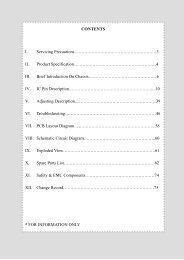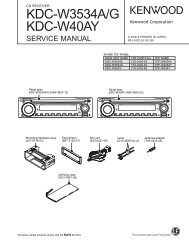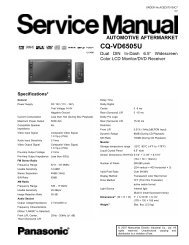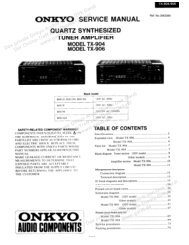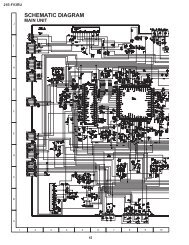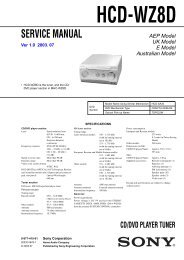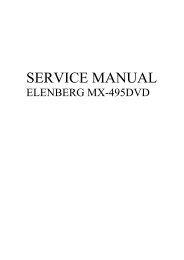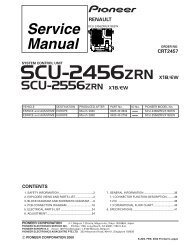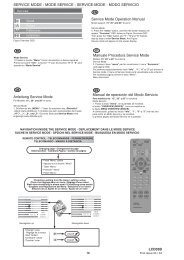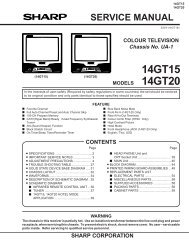Technology of Q 2500 colour TV set
Technology of Q 2500 colour TV set
Technology of Q 2500 colour TV set
Create successful ePaper yourself
Turn your PDF publications into a flip-book with our unique Google optimized e-Paper software.
<strong>Technology</strong> <strong>of</strong> Q <strong>2500</strong> <strong>colour</strong> <strong>TV</strong> <strong>set</strong>4.2.14 Signal pathAll FBAS or Y/C signals delivered by the receivingunits, the three Euro/AV sockets <strong>of</strong> thefront interface, are directed via the video matrixswitch to the video processor VPC 3230.The FBAS or Y signal is led from pin 17 <strong>of</strong>I 1711, via the impedance converter Q 1814 topin 73 <strong>of</strong> the video processor I 2271. The filterin the Y/FBAS path consisting <strong>of</strong> L 2259/57and the associated capacitors has low passcharacteristics. Frequency components over 7MHz are efficiently suppressed by the filter.This prevents floating effects in the video signal,that may arise from the cycle rate <strong>of</strong> theADC and residual signals from neighbouringchannel. For Y/C operation the chroma signalmoves from pin 14 <strong>of</strong> I 1721, via the emitterfollower <strong>of</strong> Q 1824 to filter L/C 2266, whichsuppresses noise components, and then tochroma input pin 72 <strong>of</strong> 2271.VPC 3230 is also equipped with two RGB inputinterfaces.Pins 1-3 <strong>of</strong> I 2271 are connected directly tothe Euro/AV socket 2 via the correspondinginput filter. The associated fast-blank signal isapplied to I 2271 on pin 79.Q 2226 prevents the FB voltage exceeding2.2 V and thereby damaging the videoprocessor.RGB operation via the Euro/Avc socket 2is therefore also fast blank compatible. Y/U/Voperation is also possible from the secondRGB input from pin 4 <strong>of</strong> I 2271 , 5 and 6. TheRGB signals are fed from the optimum DVBmodule or from the Euro/A socket 3 via thisinput. The same goes for the Y/U/V signals <strong>of</strong>the Euro/AV socket 3. The inputs 4, 5 and 6from I 2271 are not fast blank compatible.The video processor VPC 3230 digitises andfully processes the FBAS analogue input signalsor Y/C signal. On the output there is adigital 8-bit wide luminance and an 8-bit widedemodulated chroma signal with its U/V components.The luminance and chroma signalsare transferred in multiplex procedures viaeight LM0-7 lines. The amplitude on the linesis 3.3 Vss. The associated cycle frequency is27 MHz and is output from pin 27 on I 2271.In SAA 4979 the luminance and chroma signalsare led to a demultiplexer and read intothe internal half picture memory. Selectionresults with the 100 Hz cycle rate <strong>of</strong> 32 MHz.With 3 Mbit, slightly more than a half picturecan be stored in intermediate memory, whichpermits continuous single and dual selection.The next IC in the signal path, SAA 4993, isresponsible for noise suppression and variousinterpolations. Noise suppression is implementedby signal from the output, which hasalready been processed, being delayed for ahalf picture by the second half picture memoryand then mixed with the currently applied signal.In addition, this IC suppresses the intermediateline shimmer. Line interpolation also occurs,so that 576 lines can be displayed in allzoom functions. Movements between the picturesare also interpolated, to ensure a continuousmovement process over all half pictures.SAA 4979, which is the next IC in the signalpath, is used mainly as a DAC and for thecontrol <strong>of</strong> the digital 100 Hz video processingin the circuit.In the chroma branch there is a circuit for improving<strong>colour</strong> transitions. It is used to increa<strong>set</strong>he slope <strong>of</strong> the <strong>colour</strong> transition flanksin the differentiation and adder stages.Document Q <strong>2500</strong> 80 © Loewe ProCollege



